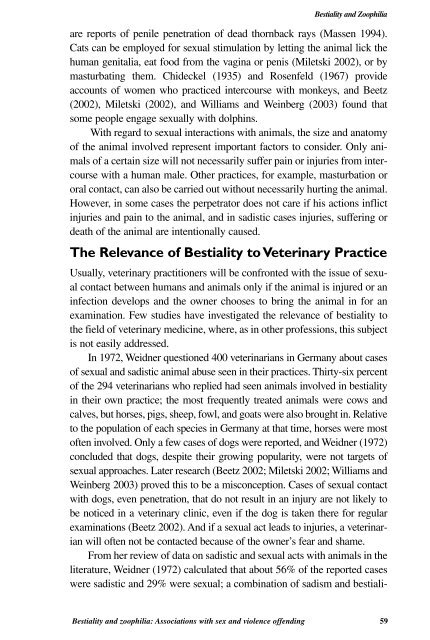Bestiality and zoophilia - Evolve For Animals
Bestiality and zoophilia - Evolve For Animals
Bestiality and zoophilia - Evolve For Animals
Create successful ePaper yourself
Turn your PDF publications into a flip-book with our unique Google optimized e-Paper software.
<strong>Bestiality</strong> <strong>and</strong> Zoophiliaare reports of penile penetration of dead thornback rays (Massen 1994).Cats can be employed for sexual stimulation by letting the animal lick thehuman genitalia, eat food from the vagina or penis (Miletski 2002), or bymasturbating them. Chideckel (1935) <strong>and</strong> Rosenfeld (1967) provideaccounts of women who practiced intercourse with monkeys, <strong>and</strong> Beetz(2002), Miletski (2002), <strong>and</strong> Williams <strong>and</strong> Weinberg (2003) found thatsome people engage sexually with dolphins.With regard to sexual interactions with animals, the size <strong>and</strong> anatomyof the animal involved represent important factors to consider. Only animalsof a certain size will not necessarily suffer pain or injuries from intercoursewith a human male. Other practices, for example, masturbation ororal contact, can also be carried out without necessarily hurting the animal.However, in some cases the perpetrator does not care if his actions inflictinjuries <strong>and</strong> pain to the animal, <strong>and</strong> in sadistic cases injuries, suffering ordeath of the animal are intentionally caused.The Relevance of <strong>Bestiality</strong> to Veterinary PracticeUsually, veterinary practitioners will be confronted with the issue of sexualcontact between humans <strong>and</strong> animals only if the animal is injured or aninfection develops <strong>and</strong> the owner chooses to bring the animal in for anexamination. Few studies have investigated the relevance of bestiality tothe field of veterinary medicine, where, as in other professions, this subjectis not easily addressed.In 1972, Weidner questioned 400 veterinarians in Germany about casesof sexual <strong>and</strong> sadistic animal abuse seen in their practices. Thirty-six percentof the 294 veterinarians who replied had seen animals involved in bestialityin their own practice; the most frequently treated animals were cows <strong>and</strong>calves, but horses, pigs, sheep, fowl, <strong>and</strong> goats were also brought in. Relativeto the population of each species in Germany at that time, horses were mostoften involved. Only a few cases of dogs were reported, <strong>and</strong> Weidner (1972)concluded that dogs, despite their growing popularity, were not targets ofsexual approaches. Later research (Beetz 2002; Miletski 2002; Williams <strong>and</strong>Weinberg 2003) proved this to be a misconception. Cases of sexual contactwith dogs, even penetration, that do not result in an injury are not likely tobe noticed in a veterinary clinic, even if the dog is taken there for regularexaminations (Beetz 2002). And if a sexual act leads to injuries, a veterinarianwill often not be contacted because of the owner’s fear <strong>and</strong> shame.From her review of data on sadistic <strong>and</strong> sexual acts with animals in theliterature, Weidner (1972) calculated that about 56% of the reported caseswere sadistic <strong>and</strong> 29% were sexual; a combination of sadism <strong>and</strong> bestiali-<strong>Bestiality</strong> <strong>and</strong> <strong>zoophilia</strong>: Associations with sex <strong>and</strong> violence offending 59


